 J.S. Fields is joining us today with her novel Ardulum: Second Don. Here’s the publisher’s description:
J.S. Fields is joining us today with her novel Ardulum: Second Don. Here’s the publisher’s description:
The Charted Systems are in pieces. Mercy’s Pledge is destroyed, and her captain dead. With no homes to return to, the remaining crew sets off on a journey to find the mythical planet of Ardulum—a planet where Emn might find her people, and Neek the answers she’s long sought. Finding the planet, however, brings a host of uncomfortable truths about Ardulum’s vision for the galaxy and Neek’s role in a religion that refuses to release her. Neek must balance her planet’s past and the unchecked power of the Ardulans with a budding relationship and a surprising revelation about her own genealogy.
Ardulum: Second Don blends space opera elements and hard science into a story about two women persistently bound to their past and a sentient planet determined to shape their future.
What’s J.S.’s favorite bit?

J.S. FIELDS
I’m a scientist.
A wood scientist.
It’s a thing, I swear. You can get PhDs in it and everything. Sometimes they even make you a professor, and then you get to spend your life explaining to people why they don’t really need to replace their deck, the grey wood is still sound, and would you please put a coaster under your drink on my Indian rosewood table before you swell the microfibrils? K thanks.
I also write books, because telling people they use cutting boards all wrong doesn’t really fulfill my creative needs. ARDULUM: SECOND DON is the second in my wood science space opera series. I wove a fair amount of hard science into the books, but not the normal kind, mostly because physics and I have a long history of not getting along. Instead, I envisioned a galaxy where wood, specifically, wood cellulose, was the backbone of the technology (as it is quickly becoming here on Earth).
You don’t get very many chances to geek out over hard science in space opera—it’s meant to be more of a fun ride with at least one decent sized ship explosion more than an academic treatise. Still, I wanted the cellulose science in the ARDULUM series to be strong enough to hold its own should any of my unsuspecting graduate students get their hands on it (which has already happened, I’ve been told, and there is some horrifying plan to dress up as my characters for Halloween…during the school day). So I spent a fair amount of time in FIRST DON laying out the hows and whys of cellulose integration and manipulation: how it was layered into electronics and spaceships, how it reinforced lasers, etc.
But book two, oh, book two. With all the pesky hard science out of the way, the explanations already done, in SECOND DON, I finally got to play. It also meant that I got to dream bigger, since the groundwork for cellulose tech was already well defined in the series. So what does a wood science PhD do with such freedom? Well, I can’t speak for the twenty or so others on the planet, but I decided it was time to start playing with hemicelluloses.
In the Ardulum series, the various systems and galaxies all share a common technological core—their spaceships, weapons, and propulsion systems are all cellulose based. Communication, both on world and off, requires cellulose fibers. Nothing is untouched by cellulose, no matter how primitive or advanced a civilization. The main driver of tension across the series is the existence of a species that has a very specific form of telekinesis—they can manipulate cellulose to the point of seeing its crystalline forms, rearranging bonds, and generating huge amounts of energy from screwing around with hydrogen bonding.
How, then, does one defeat such a species while still maintain some basis of technology? The nerdiest answer is hemicellulose. Hemicellulose is still a sugar polymer, but unlike cellulose (basically a long chain of glucose), hemicellulose is branched and made of up several different sugars (and the specifics of those sugars varies by tree type). Some examples are xylan and galactoglucomannon (my Twitter handle is @galactoglucoman, which I think is hysterical). Even in current tech and engineering today, hemicellulose just doesn’t have the same capacity as cellulose, but it’s better than nothing.
With that in mind, I wrote the use of hemicellulose into the backstory of the Charted Systems. There is a scene in SECOND DON where the crew are in a shipyard, looking to purchase a used spacecraft. Nicholas, our POV character for the chapter, runs his hands across a number of old model ships, and gets to have a very geeky internal monologue about early lightspeed history, the use of xylans in Earth’s first deep space shuttles, and how the technology evolved into fully integrated cellulose use. This sets the groundwork for THIRD DON, coming out in 2018, for when some species are forced to reverse engineer their spaceships back to old hemicellulose technology, in order to protect themselves from an increasingly aggressive group of telekinetic cellulose users.
Personally, one of the best parts of writing the ARDULUM series has been integrating these small, super nerdy cellulose snippets into the world building. I’m sure plenty of readers skip over them, since it isn’t pivotal for understanding the plot, but I love getting the chance to see the tech that I work with every day, or that is just a few decades out from being in consumer hands, be realized in an otherwise fun little space opera.
Plus, it apparently gives my graduate students something to dress up as for Halloween.
LINKS
BIO
J.S Fields is a scientist who has perhaps spent too much time around organic solvents. She enjoys roller derby, woodturning, making chainmail by hand, and cultivating fungi in the backs of minivans. Nonbinary, but prefers female pronouns. Always up for a Twitter chat.
